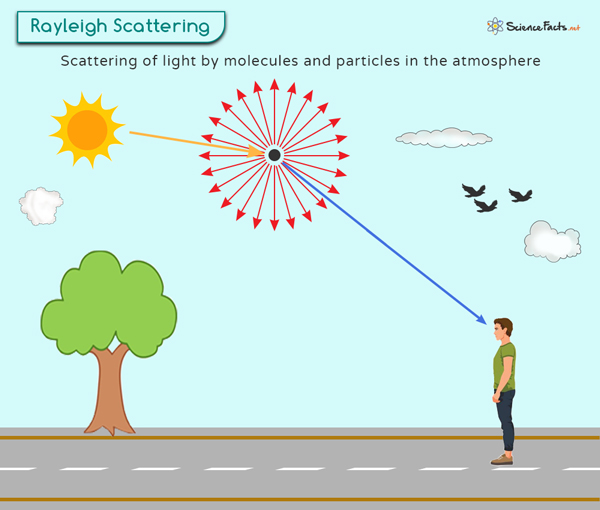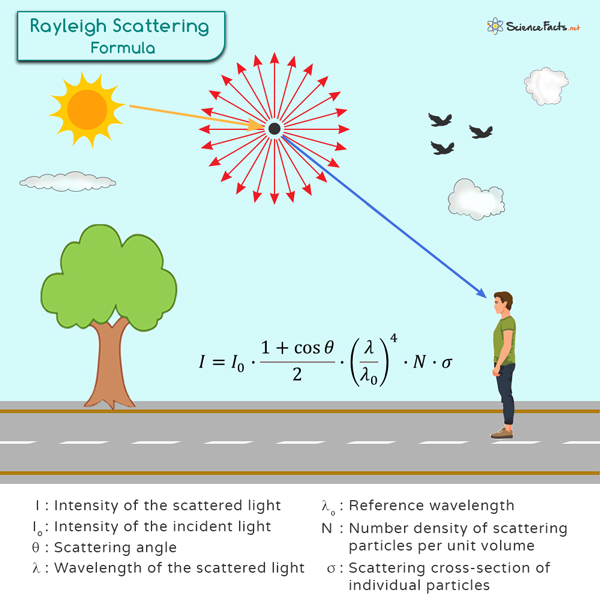Rayleigh Scattering
Rayleigh scattering is a phenomenon in physics that occurs when light waves interact with particles or molecules smaller than the wavelength of light. Typically, it refers to the scattering of light by particles or molecules in the atmosphere. When sunlight passes through the Earth’s atmosphere, it interacts with air molecules, dust particles, and other small particles present in the atmosphere. This interaction causes the light to scatter in various directions.
Rayleigh scattering is named after British mathematician and physicist Lord Rayleigh, who first described this phenomenon in a paper in 1871.
What causes Rayleigh Scattering
Rayleigh scattering is due to the electric polarizability of the particles. Light waves have oscillating electric fields that interact with the charges within a particle, allowing them to move at the same frequency. Therefore, the particle becomes a small radiating dipole whose radiation we observe as scattered light.
Why is the Sky Blue
The significance of Rayleigh scattering lies in its effects on the color and intensity of sunlight. Sunlight is composed of various colors, each corresponding to a different wavelength. When sunlight enters the Earth’s atmosphere, it encounters molecules such as nitrogen and oxygen, as well as small particles like dust and water droplets. These molecules and particles are much smaller than the wavelength of light.
During Rayleigh scattering, the shorter wavelengths of light, such as blue and violet, are scattered more by the molecules and particles compared to longer wavelengths, such as red and orange. The reason is that the shorter wavelengths are closer in size to the molecular and particle dimensions.
As a result, sunlight scatters more blue light in all directions than any other color when it passes through the atmosphere. This scattered blue light reaches our eyes from all directions, making the sky appear blue.
It is worth noting that if our atmosphere had different molecules or particles, or if the particles were larger than the wavelengths of visible light, we might observe a different sky color.
Formula
Rayleigh scattering formula provides a quantitative explanation for the intensity of light scattered by particles much smaller than the wavelength of the incident light. According to Rayleigh’s law, the intensity of scattered light is inversely proportional to the fourth power of the wavelength. As far as the effect of particle size on Rayleigh scattering is concerned, the scattering efficiency increases with decreasing particle size. Smaller particles have a larger surface area relative to their volume, which enhances their ability to scatter light. It is why atmospheric molecules, typically tiny compared to the wavelength of visible light, effectively scatter sunlight.
The Rayleigh scattering formula can be expressed as:
Each term in the Rayleigh scattering formula contributes to our understanding of how light interacts with particles in the atmosphere:
The Rayleigh scattering formula highlights the reasons behind the observed blue color of the sky during daylight hours. Additionally, the formula helps explain the varying color of sunlight during sunrise and sunset, where longer path lengths through the atmosphere result in enhanced scattering of shorter wavelengths and a reddish hue.
Limitations
While the Rayleigh scattering formula provides a solid foundation for understanding light scattering in clear atmospheres, it has limitations. It assumes ideal conditions, such as a uniform distribution of particles and isotropic scattering. In reality, atmospheric conditions can be more complex, leading to deviations from the formula’s predictions. More sophisticated models, like Mie scattering for larger particles, may be necessary in such cases.
-
References
Article was last reviewed on Thursday, August 31, 2023









